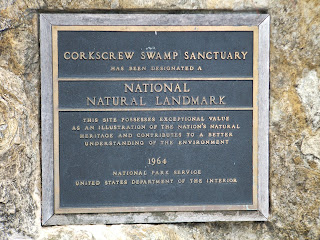Good for one can be good for all.
I went to Corkscrew Swamp Sanctuary because "Ellas Trails" website said they had a unique boardwalk. I'm a tree-hugger, but I started a photo essay on boardwalks so I drove three hours to see it. I was not Disappointed. You can see a full foto-tour of this boardwalk on Green Scenes at http://www.facebook.com/pages/Green-Scenes/420724504625089
The wood is NOT pressure treated. They did not want the pressure treating chemicals leaching out into the swamp or water. So...the got a tropical hardwood, sustainably grown, and built the boardwalk- almost 3 miles worth, out of that.
The birds were saved by Audubon, but they saved the trees, the bears, the panthers and the other swamp animails almost by accident.....and built a great boardwalk and education center. Thanks Ella's Trails! http://www.ellastrails.com/categories/47,43/search_type/and/order/default/ They have a search by state and trail surface (among others). I put on boardwalk and Florida and found the Corkscrew Swamp Sanctuary.
From Audubon Florida about the Sanctuary-
"Corkscrew Swamp Sanctuary occupies approximately 13,000 acres in the heart
of the Corkscrew Watershed in Southwest Florida, part of the Western
Everglades. It is primarily composed of wetlands. These include the largest
remaining virgin bald cypress forest in
the world (approximately 700 acres), which is the site of the largest
nesting colony of Federally Endangered Wood Storks in the nation. In addition
to the wood stork, Corkscrew provides important habitat for numerous other
Federal and State listed species, including the Florida Panther, American
Alligator, Gopher Tortoise, Florida Sandhill Crane, Limpkin, Roseate Spoonbill,
Snowy Egret, Tricolored Heron, White Ibis, Big Cypress Fox Squirrel and the
Florida Black Bear. Several rare plants are also found here, most notably the
Ghost Orchid.
Sandhill Cranes
Corkscrew is in a strategically important location, and the quality of the
natural resources here provides excellent habitat for wildlife. Our wetlands
recharge the local aquifers, rivers and estuaries, providing the right
conditions for fishing and coastal recreation as well as clean drinking water
and water for agricultural productivity.
A variety of battles over birds, lumber, water and land spanning more than a
century has transformed Southwest Florida. Much of the area bears little
resemblance to its native roots, yet Corkscrew remains a vibrant wet
wilderness. We are inextricably connected to our past and to our neighbors. The
demand for resources and space presses on and in. Our ability to sustain some
of our larger more charismatic creatures like the wood stork and panther is
sure to be tested. We are a sanctuary for wild Florida, a living natural
history repository open 365 days per year. We are committed to protecting and
preserving this patch of ground for the benefit of the wild things that depend
on Corkscrew.
Recycling nutrients from a 600 year old Cypress tree is turned into fern...
It was around 1900, when egret and heron plumes were in high demand for use
in the fashion industry. By 1913, a deputized Warden of the Audubon Society
named Rhett Green had begun serving as a guide for people like Thomas Gilbert
Pearson, F.M. Phelps, Oscar E. Baynard and W. F. Blackman who were documenting
the bird life found at Corkscrew. The combination of rookery protection and a
campaign to stop the demand for the plumes was successful. The plume hunters
went away, and so did the Audubon’s wardens.
Systematic logging of South Florida cypress forests started in 1944 south of
Corkscrew. Much of the lumber went to assist in the rebuilding of Europe after
WWII. By the early 50's networks of logging roads were constructed and massive
500 year old trees were being pulled out. Locals were alarmed at the prospect
of losing all the great cypress forests to logging and began a campaign to save
the swamp. The National Audubon Society and a long list of organizations and
individuals worked together to raise the support necessary to purchase the last
expanse of virgin bald cypress left in the world, which also housed the largest
and most important wood stork rookery in the United States. By 1954, 5,680
acres were secured (640 acres were a gift from Lee-Tidewater Cypress Company)
and the Corkscrew rookery became Corkscrew Swamp Sanctuary.
In 1955, in the absence of any state interest in managing the swamp, Audubon
took ownership of this great Corkscrew rookery. The initial Sanctuary was 5,680
acres. We eventually grew, adding an additional 5,320 acres, the latest
acquisition was the Panther Island Mitigation Bank. Our fledgling sanctuary was
accessible only by four-wheel drive vehicles along a remote dirt road.
More than ever, we are dependent on support and partnerships with private
citizens, neighbors, elected officials and folks making land use decisions. We
place a premium on educating all who will listen on the value of Corkscrew and
natural areas.





No comments:
Post a Comment